As soon as divine service was over, the Thorpes and Allens eagerly joined each other.
—Northanger Abbey 28
Jane Austen’s religious faith and Anglican worldview shaped her novels, as scholars such as Laura Mooneyham White, Michael Giffin, William Jarvis, Irene Collins, Roger E. Moore, and others have shown. Her novels often mention church and clergy as well as church-related issues. This is not surprising. Jane Austen’s father and many of her relatives were clergymen, and she grew up in the parsonage of a country church, so she knew the lives and world of clergy families well. Northanger Abbey begins and ends at such a country church. The heroine, a clergyman’s daughter, expands her horizon as she travels to Bath, a city with a wide range of churches and chapels. She attends a chapel there that would have been quite different from her parish church. Catherine then experiences an abbey, which Moore claims is a symbol of England’s lost Catholic heritage, degraded from a place of hospitality for all into a place welcoming only the rich (93–94). When Catherine is forced to leave the abbey, the spire of a cathedral points her way back home. Finally, she settles into the parsonage of another country church with her clergyman husband. These places of worship give us windows into Catherine’s experiences.
The four types of places of worship mentioned—churches, chapels, abbeys, and cathedrals—each had a distinctive place in English life and worship. A “church” was a Church of England parish church. Each of England’s 11,600 parishes had one parish church, intended for everyone in the parish to attend. If the church was too small or if some parishioners lived too far away, “chapels of ease” were built to ease the burden on the mother church. Bath, growing quickly and hosting many visitors, included many of these chapels of ease. Private, institutional, and Dissenter chapels filled other needs. Parishes in a geographical area were, and still are, combined into a diocese supervised by a bishop, whose “seat,” or center of authority, is in a cathedral. Abbeys were large monasteries or convents, but after Henry VIII dissolved the monasteries in the 1550s, some became churches like Bath Abbey, others became private residences like Northanger Abbey, and some deteriorated into the picturesque ruins for which Catherine Morland longs.
Country churches in Northanger Abbey
Catherine Morland’s “father was a clergyman. . . . He had a considerable independence besides two good livings” (5). Catherine thus grows up in a country parsonage, near a parish church. Her father is the parson of two churches, in two parishes. Such country churches were usually small. Most parishes included fewer than five hundred people; many had fewer than one hundred (Collins 92). It is only in Bath that Catherine begins to meet and worship with a wider variety of people, gaining a better understanding of the world.
Jane Austen provided her heroine with a similar background to her own, but more wealth. Catherine Morland’s father and Jane Austen’s father were both clergymen with large families, and each held two livings, including at least one family living, since the patrons of Steventon were George Austen’s cousins, the Knights. Both had an eldest son named James, who followed in one of those livings. Annually, George Austen received around £900 total for his two livings by 1800, while one of the Morland livings was £400 and the other probably more. The two clergymen were different, however, in that Rev. Morland had a “considerable” private income besides his clerical income, enough to leave a good inheritance for the children, while George Austen had little private income and little money to leave to his wife and daughters.
A clergyman’s “living” came from tithes (10% of his parishioners’ agricultural income), farmland called glebe, and fees for performing ceremonies. The living Mr. Morland offers his son is worth £400 a year. Such an income was enough to provide basic comforts, including a few servants: a cook, a housemaid, and possibly a boy (Copeland 131). Isabella, however, considers this income “‘hardly enough to find one in the common necessaries of life’” (138). She expects a carriage, at least (125), which would require an income closer to £1000, like that of Dr. Grant in Mansfield Park.
Mr. Morland promises James an “estate of at least equal value” as his “future inheritance” (137). If the other nine children were to inherit equal amounts, this would make Mr. Morland’s “considerable independence,” from other property and investments, £4000 a year, the income of a wealthy man like Henry Crawford or Mr. Bingley. This amount may have deceived the Thorpes into thinking that James and Catherine would be wealthy, especially added to an inheritance from the Allens. Sharing that wealth among ten children, however, dilutes it substantially! And, in fact, Catherine’s dowry is only £3000, giving her £150 a year, so not all the children were to receive as much as James is promised.
Mr. Morland is both “patron and incumbent” (137) of the living he offers James. He probably came from a wealthy family and inherited, or bought, the right to assign that living. Henry Tilney also holds a family living, of which his father is patron. When the Tilney family took over Northanger Abbey after the monasteries were dissolved, they would have also received the advowsons, that is, the rights to assign a living, for parishes under the monastery’s patronage, including Henry’s parish of Woodston (Moore 92). General Tilney boasts that the Woodston living is not “‘a bad one’” and that it would be sufficient to support Henry even if he had no other income (180). So it is probably another generous living, like that of Mansfield Park. Once a living was assigned, the clergyman held it until he died; the patron could not take it away. Henry is thus financially independent of his father; he no longer needs his father’s approval to marry, though in the end he receives it.
During the course of the novel, Henry is only a part-time resident of the Woodston parsonage. He has a curate who apparently usually leads Sunday services, though Henry does it when the curate cannot (229). Henry is diligent, however, in attending parish meetings (216), where church and parish business was discussed. As Celia Easton points out, Henry Tilney is fully committed to his parish in an age when many clergymen neglected their responsibilities (160). When Catherine visits the parsonage, she is delighted, hoping it will be her future home. General Tilney boasts that “‘there are few country parsonages in England half so good,’” but that it “‘may admit of improvement’” (219). He drops obvious hints that Catherine will be the one to improve it. In fact, after Henry’s father forbids his marriage, Henry moves completely into the parsonage at Woodston and continues “improvements” there (259) until he and Catherine marry and live there together. Henry Tilney is presumably now the full-time clergyman at Woodston, fulfilling all his duties there with Catherine at his side.
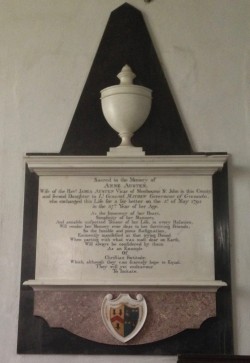
Elegant monument to Anne Austen, Steventon Church. © Brenda S. Cox (Click here to see a larger version.)
While Catherine is at Northanger Abbey, she attends another parish church, the one closest to the abbey. She and the Tilneys go to both morning and afternoon services on Sunday, which seems to have been the practice in Jane Austen’s family as well (White 32). In this small country church, like Austen’s church at Steventon, monuments on the wall commemorate important people who have died. Catherine’s eye is caught by “a very elegant monument to the memory of Mrs. Tilney, which immediately fronted the family pew” (195). A monument might be anything from an elaborate plaque to a sculpture. This one includes a “highly-strained epitaph” (195) praising Mrs. Tilney’s virtues. The walls of the Steventon and Chawton churches both have such monuments.
Jane Austen would have seen the monument to James Austen’s wife Anne, who died in 1795, on the wall of the Steventon church. Its epitaph begins, “As the Innocency of her heart, Simplicity of her manners, and amiable unspotted Tenour of her life, in every Relation, will render her memory ever dear to her surviving Friends.” General Tilney’s pride and wealth no doubt provided something even more elaborate for his wife.
Catherine sits with the Tilneys in their “family pew,” which they probably own. It is most likely a box pew in the front of the church, with high walls around it to keep out drafts and to give the family privacy.
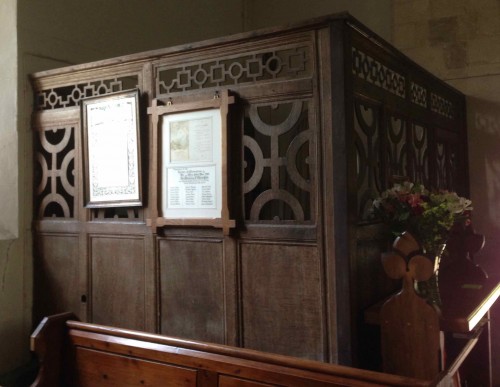
Digweed family pew, a box pew in Steventon Church. © Brenda S. Cox
In Austen’s England, the rich took the best seats in church, often paying for those seats, while the poor were left to sit or stand in the aisles, the back of the church, or the balconies (galleries). In Bath, however, a group of people, including William Wilberforce and many clergymen, were concerned that this practice made the poor feel unwelcome in church. They raised money to build the first English church designed to be free for the poor. Wealthier people rented pews in the gallery to help pay church expenses, but the seating on the main floor was free. Christ Church, opened in 1798, is still a thriving church in modern Bath, though of course ways of funding churches have long changed.
Churches in Bath
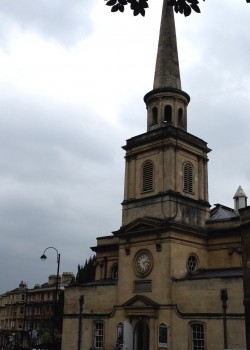
St. Swithin’s Walcot Church.
© Brenda S. Cox
In Bath, Catherine tells Henry Tilney that at home she can only call on Mrs. Allen, but “‘here I see a variety of people in every street’” (77). She would have seen not only a variety of people but a variety of places of worship. When Catherine Morland leaves her small country parish with only one church and goes to Bath, she enters a city full of churches and chapels. The central parish was originally three parishes, combined into one under Queen Elizabeth, so it had three churches: Bath Abbey (the Abbey of St. Peter and St. Paul), St. Michael’s, and St. James’s. The city of Bath Corporation chose the rector and curates for those churches. The northern part of Bath is in the parish of Walcot. Its church, St. Swithin’s, seems to be the only contemporary church that Austen specifically names in her novels (Bain). John Thorpe passes it as he sweeps into Bath on the London Road. He boasts that his horse “‘had not turned a hair till we came to Walcot Church’” (NA 40). This church was connected to Jane Austen’s family. Her parents were married there in 1764, and her father was buried there in 1805. William Wilberforce, who led the campaign to abolish the slave trade, was also married at the Walcot Church, in 1797. When Jane Austen stayed with her aunt and uncle in the Paragon, Bath, she wrote to Cassandra that they had been to church twice on Sunday (12–13 May 1801). Most likely they went to St. Swithin’s, which was up the hill from where her aunt and uncle lived.
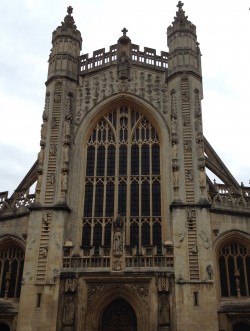
Bath Abbey, now a parish church.
© Brenda S. Cox
(Click here to see a larger version.)
The most conspicuous church in Bath is Bath Abbey.1 Bath Abbey was once the church of a Benedictine monastery. When Henry VIII separated from the Catholic church in order to divorce Queen Catherine of Aragon and marry Anne Boleyn, he dissolved the monasteries, which held great wealth and lands. Henry’s wars had put the country deep in debt, and the monastery lands were sold off (1536–1540) to provide income for the Crown. Bath Abbey, like some other monastery churches, fell into ruins. It was restored under the reign of Elizabeth I by donations from all over England. Bath Abbey is not mentioned in Northanger Abbey, although its church-yard, next to the Pump-room, is mentioned twice: when the young men Catherine and Isabella are supposedly trying to avoid go “‘towards the church-yard’” (36) and when Catherine, on her way from the Pump-room to the Tilneys’ lodgings, goes “tripping lightly through the church-yard” (90). Moore suggests that Austen’s not mentioning Bath Abbey in Northanger Abbey may be an oblique criticism of Bath society: Bath had once been a place to seek spiritual as well as physical healing, but in Austen’s England an obsession with entertainment had replaced any spiritual emphasis (98–104).
Chapels in Bath
At the end of the eighteenth century, most wealthy visitors to Bath worshiped in chapels. These were “proprietary chapels,” built to make a profit; residents or visitors paid a fee for regular seats. Catherine Morland and Isabella Thorpe, as new friends who have to separate at the Allens’ door, are relieved to learn that they will “say their prayers in the same chapel the next morning” (26). In other words, Catherine and Isabella will attend worship together in a chapel, following the Book of Common Prayer, which includes prayers read aloud by the clergyman and by the congregation. For Catherine, the service itself would be similar to worship in her country church, but the surroundings would be quite different.
It is not clear which chapel in Bath Jane Austen had in mind. Catherine and the Allens are staying in the eastern part of Bath, in fashionable, expensive Great Pulteney Street (12). The closest chapel to them is Laura Chapel, in Laura Place. (In Persuasion, Lady Dalrymple lodges in Laura Place.) The Thorpes are staying more centrally in Edgar’s Buildings (36). They are closer to the Octagon Chapel in Milsom Street, the street where the Tilney family lodges and where Isabella and Catherine shop.
Austen might have had either of these fashionable chapels in mind. Both were luxurious. Catherine’s country church, in comparison, would probably be small, whitewashed inside, with perhaps the Ten Commandments or the Lord’s Prayer on the wall for decoration, and a few monuments. In the winter it would be very cold. In contrast, both the Octagon and the Laura Chapel were elegantly decorated and were heated with fireplaces. The Laura Chapel opened in 1796, so it was new when Austen was writing Northanger Abbey. It was quite large, seating 1000 people (Stone 64). Two entrances to the Laura Chapel still remain, but not the interior.
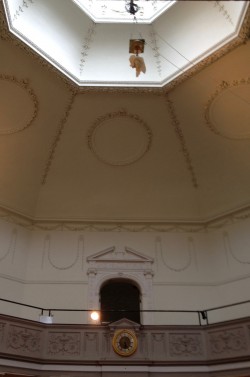
Octagon Chapel interior, gallery and cupola (2014). © Brenda S. Cox
The Octagon was also luxurious, with carpeted floors and private fireplaces in the box pews. When Parson James Woodforde visited the Octagon in 1769, he commented in his Diary, “It is a handsome building, but not like a place of worship, there being fire-places in it, especially on each side of the Altar, which I cannot think at all decent, it is not liked” (55). Visitors like the pleasure-loving Allens and Thorpes probably enjoyed the warmth. The Octagon offered four services a week and had four hundred paid seats, costing six to ten shillings a month per person, with fifty free seats for visitors (Medd). After a newcomer’s first visit, he or she had to rent a sitting, as in all private chapels in Bath.
Mr. Allen with his “gouty constitution” (9) might also have appreciated the accessibility and healthfulness of the Octagon. When it opened in 1767, it was advertised as “the only safe place of worship in Bath as there are no steps to climb and no bodies buried below” (Stone 53). This description was in pointed contrast to Bath Abbey. Visitors to the Abbey, a fashionable place for the wealthy to be buried, complained of foul, unhealthy smells: more than three thousand bodies were buried under its floor, and when the floor was opened for a new corpse to be interred, previously buried bodies could be smelled decomposing (Hylson-Smith 156). The private chapels were healthier and more pleasant.
The Octagon also drew people like the Allens and the Thorpes through its music. Country churches rarely had musical instruments, though they might have a few string or wind instruments. City churches often provided organ music. At the Octagon, Catherine would have experienced both art and music far beyond what she found in her country church. The Original Bath Guide of 1819 states that the Octagon was “greatly admired for its neatness and elegance,” with a “fine altar-piece representing the Pool of Bethesda, painted by Mr. Hoare, and an excellent organ” (32). The chapel’s first organist was the musician and astronomer William Herschel, who later discovered the planet Uranus from his back yard in Bath. (Pipes from the organ he played at the Octagon are on display at the Herschel Museum of Astronomy in Bath.) Unlike most of the Bath chapels, the Octagon’s hall still remains; it has been an antique shop, a World War II food office, a photographic exhibition hall, and a restaurant (“Octagon Chapel”).
Jane Austen may well have attended Laura Chapel during the three years she and her family lived in Sydney Place; it would have been the closest chapel for them. In earlier years when they stayed in Queen Square, as well as later when they lived in Green Park Buildings, Gay Street, and Trim Street, however, her family probably attended the older, and likely less expensive, Queen Square Chapel. From Gay Street Austen wrote, “on leaving Chapel, we walked to Lansdown. . . . Mrs Buller goes with us to our Chapel tomorrow” (8–11 April 1805). “Our chapel” means that their family had paid for a subscription. Austen specifically mentioned the Queen Square Chapel, as a location Cassandra would be familiar with, in a letter of 3–5 January 1801. This proprietary chapel had a classical design and was dedicated to the Virgin Mary. It opened in 1734 and was demolished around 1870 to improve access to a railway station (“Queen Square Chapel”).
Other types of chapels
Two other types of chapels are mentioned in Mansfield Park, though not in Northanger Abbey: private chapels and institutional chapels. Wealthy people like the Rushworths could have a private chapel in their home and their own chaplain. Fanny Price mourns the loss of daily prayer for the household at Sotherton (101). Family prayer had been more common in previous generations and became popular again in the Victorian era. Austen’s family seems to have been in the habit of reading daily prayers together at home (White 33). The chapel at Sotherton may have been based on the private chapel at Stoneleigh Abbey, which Austen had visited. Her mother’s cousin, Rev. Thomas Leigh, inherited the Abbey and instituted morning and evening family prayers there (Collins 12).
Chapels might also be places of worship for specific institutions. Bath had institutional chapels at two hospitals, including a “Hospital for Lunaticks” (Warner 80) under Beechen Cliff, where Henry Tilney teases Catherine and his sister as they walk. Fanny Price and her family attend the Garrison chapel in Portsmouth for military personnel (MP 473, 727), and Edmund Bertram remembers required daily services at his chapel at Oxford (103). Another college chapel is mentioned obliquely in Northanger Abbey. John Thorpe buys his carriage from a “‘Christ-church man’” (40). The lovely chapel at Christ Church College, Oxford, is also the cathedral for the Oxford diocese! John and Charles Wesley, who began the Methodist movement, both attended Christ Church College at Oxford.
Since “church” referred only to a Church of England parish church, places of worship for the Methodists and other Protestant denominations (Dissenters, or Nonconformists, not conforming to the Church of England) were called chapels or meeting houses. Catherine Morland’s country parish probably did not include any of these (Steventon apparently did not), but she would have seen many such chapels as she walked around Bath. A visitors’ guide to Bath in 1801, the year Jane Austen moved to Bath, advertised “places of Divine Worship for all the denominations of England that are popular and prevalent,” including Lady Huntingdon’s Chapel, Wesleyan Methodists, Independents (Congregationalists), Unitarians (formerly Presbyterians), Roman Catholics, Quakers, Moravians, and Baptists (Historic and Local New Bath Guide 51). Only Mansfield Park mentions Dissenters, as Mary Crawford angrily tells Edmund, “‘when I hear of you next, it may be as a celebrated preacher in some great society of Methodists’” (530). Such “great societies of Methodists” were spreading across England among the lower classes and were known for powerful, emotional preaching and an emphasis on personal conversion. They were originally part of the Church of England but separated from it in 1795. Of the Dissenter chapels Catherine might have seen in Bath, only a few remain: Lady Huntingdon’s Chapel, which was the Countess of Huntingdon’s “private” chapel as well as a Calvinistic Methodist chapel and is now the Building of Bath Museum; the Argyle Street Chapel, which was an Independent Chapel and is now a United Reformed Church; and the Old Orchard Street Theatre, a former Catholic chapel.
Catholics faced bigger challenges than other Dissenters in Austen’s England. After the Reformation there was widespread prejudice against Catholics, mostly for political reasons. By Jane Austen’s time, though, more than two hundred years after Henry VIII dissolved the monasteries, England had become somewhat more tolerant. Catholics could worship publicly, although they still had limited civil rights. Not everyone supported even those limited rights. Anti-Catholic rioting is referred to in Northanger Abbey when Henry, Eleanor, and Catherine walk on Beechen Cliff (Moore 105). When Catherine says that something “‘shocking’” will be coming out soon in London, meaning a new gothic novel, Eleanor misunderstands, according to Henry, “‘immediately pictur[ing] to herself a mob of three thousand men assembling in St. George’s Fields; the Bank attacked, the Tower threatened, the streets of London flowing with blood’” (114). Henry describes an anti-Catholic riot that occurred after passage of a 1778 act giving Catholics a few limited rights. In 1780, Lord George Gordon tried to get that act repealed and assembled a mob to loot and pillage in London. They shouted, “No Popery!” as they burned down Catholic chapels and priests’ houses, attacked the Bank of England, and destroyed prisons. The rioting lasted for about a week. Over 400 rioters were killed during the riots or executed afterwards.
In 1780 anti-Catholic rioting also erupted in Bath. Rioters burned down the Catholic chapel in St. James Parade as well as the bishop’s house and the priest’s house. The city of Bath responded strongly, hanging the ringleader, a “gentleman’s servant, . . . taking up the infuriate rancour of the times” (Original Bath Guide 34). A tax was levied on the city to pay for the damages, and a new, “less conspicuous” chapel was built in Corn-street. By 1809, the Catholics needed a larger facility. The theatre in Bath when Northanger Abbey was written (1798–1799) was in Orchard Street. It closed in 1805 when the current Theatre Royal opened in a better part of town. The Catholics took over the old Orchard Street Theatre and remodeled it as a “neat, spacious and convenient Chapel” that could seat more than a thousand people, with “an excellent organ, aided by a brilliant choir” (Original Bath Guide 34). Catholics worshipped there from 1809 to 1863, and from 1865 until the present it has been a Masonic Hall (Toogood).2
Abbeys
While some Catholic abbey churches became Anglican churches or cathedrals, others became private estates, like Northanger Abbey and Stoneleigh Abbey. Lacock Abbey near Bath may have been a model for Northanger (Cantrell). Owners like the Leigh family and Austen’s Tilneys often completely rebuilt the former abbeys. When Jane Austen’s mother visited Stoneleigh Abbey in 1806 with her daughters, she expected “long Avenues, dark rookeries & dismal Yew Trees,” but found “no such melancholy things” (qtd. in Le Faye 156). She did find, though, “the State Bed chamber with a high dark crimson Velvet Bed, an alarming apartment just fit for an Heroine” (157). This visit was well after Austen wrote the early version of Northanger Abbey in 1798–1799; perhaps it influenced Austen’s 1816 revision.
Catherine Morland also finds the abbey to be different than she expected. Before visiting, she exults that “[w]ith all the chances against her of house, hall, place, park, court, and cottage, Northanger turned up an abbey, and she was to be its inhabitant. Its long, damp passages, its narrow cells and ruined chapel, were to be within her daily reach” (143). She hopes to see the small cells where monks or nuns slept, and a “ruined chapel.” An abbey’s chapel was the “costliest and most richly decorated part of the house” (Moore 90). Such chapels were destroyed and looted by Henry VIII’s agents so that the monastery could no longer be a center of worship. Catherine also hoped for “some traditional legends, some awful memorials of an injured and ill-fated nun” (144). As Moore points out, the nuns cast out when their convents were dissolved had to return to their families, who were often poor, or else had nowhere to go; they were all “ill-fated” (94).
Catherine’s imagination is so active that even after questioning Miss Tilney, Catherine is “hardly more assured than before, of Northanger Abbey having been a richly-endowed convent at the time of the Reformation,” which fell “into the hands of an ancestor of the Tilneys on its dissolution” (144). Similarly, Stoneleigh, a Cistercian monastery founded in 1154, fell into the hands of the Leighs’ ancestor, Sir Thomas Leigh, Lord Mayor of London, in 1558 (“Stoneleigh Abbey”). Catherine expects “massy walls of grey stone, rising amidst a grove of ancient oaks, with the last beams of the sun playing in beautiful splendour on its high Gothic windows” (164). Instead she is ushered into a modern drawing room, where even the windows are disappointing. “To be sure, the pointed arch was preserved—the form of them was Gothic—they might be even casements—but every pane was so large, so clear, so light! To an imagination which had hoped for the smallest divisions, and the heaviest stone-work, for painted glass, dirt and cobwebs, the difference was very distressing” (165–66). Like Mrs. Austen at Stoneleigh Abbey, Catherine finds Northanger Abbey less Gothic than she had expected. Only the cedar chest in her bedroom excites her interest (167), though, as Duquette points out, when Catherine goes to her room during a storm, the sounds of the tempest finally begin to make her feel that she is “really in an Abbey” (NA 171), and she does appreciate its grandeur when she sees the whole complex from the lawn (182).
Jane Austen was familiar with a ruined abbey more like what Catherine imagined. She mentioned Netley Abbey in letters of June 20–22 and October 24–25, 1808, while she, her mother, and her sister were living nearby in Southampton. She and her niece Fanny were quite impressed by it. Various eighteenth-century poets wrote about Netley Abbey, lamenting its destruction as a holy place, a place of prayer (Moore 79–84). It is possible that Northanger Abbey also laments the passing of the monasteries, which were places of hospitality and welcome for everyone. General Tilney’s Northanger Abbey, in contrast to the ancient abbeys, is only open to the wealthy (Moore 93–94). When the General discovers Catherine’s lack of fortune, he heartlessly casts her out.
And a cathedral
As Catherine heads home, she “rather dreaded than sought for the first view of that well-known spire which would announce her within twenty miles of home. Salisbury she had known to be her point on leaving Northanger” (240). The spire she dreads seeing is the spire of Salisbury Cathedral. Catherine lives in Wiltshire (9), so her father’s parish is part of Salisbury diocese, which includes several hundred parishes. The seat of the bishop of the diocese has been at Salisbury Cathedral since 1092, and the spire that Catherine sees is the tallest in Britain.
Because she died in Winchester, Jane Austen is buried in another cathedral, Winchester Cathedral. She lived most of her life in the parishes of Steventon and Chawton, in the diocese of Winchester. Winchester Cathedral is on the site of an earlier monastery church of a Benedictine community.
Northanger Abbey begins and ends with a parish church. It brings us full circle from Catherine’s happy childhood, growing up in her father’s parsonage, to another parsonage where she and her clergyman husband will bring up their own children. In many country churches, church bells in a tower announced events and called people to services.3 In Northanger Abbey, Catherine and Henry are finally married, most likely by her clergyman father in her parish church at Fullerton, before they move to Henry’s parsonage and parish church at Woodston. “The bells rang, and every body smiled” (261).4
NOTES
1Visitors often assume that Bath Abbey, an impressive, Gothic-style church, is also a cathedral. Bath, however, is part of the diocese of Bath and Wells; the cathedral is at Wells. Bath Abbey was a cathedral for a while in medieval times, so it is still sometimes called a “cathedral church of Bath.” Westminster Abbey in London was similarly a monastic church or abbey, then temporarily a cathedral, and is now a church, though not a parish church; it is directly responsible to the king or queen rather than to a bishop.
2Curiously, the Masons had previously met in a building which became a Quaker meeting house when they moved out of it; it is still a Quaker (Society of Friends) church today. Jane Austen, by the way, knew Quakers in Alton, near Chawton. The apothecary who treated her in her last illness was a Quaker, as were other businessmen in the town. (The Quakers were a prominent group of Dissenters in Austen’s England.)
3Visitors can still hear the bells at the churches Austen attended in Steventon and Chawton; JASNA helped restore the bells at both churches.
4For more photos of churches, chapels, abbeys, and cathedrals mentioned in this article, see brendascox.wordpress.com/2017/11/16/churches-chapels-abbeys-and-cathedrals-in-northanger-abbey/ and other articles on that website.
